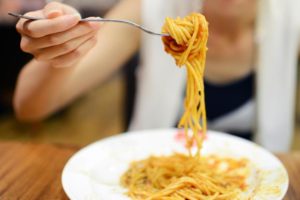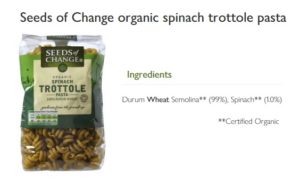
You’ve probably seen these relatively new additions to the dried pasta ranges – lentil fusilli, chickpea penne, etc. Are they just another marketing fad with no health benefits over the usual wheat pasta, or do they provide some of the same health benefits for which lentils and chickpeas are well known? Let’s see…
Blog Contents
What’s the problem anyway?
Well, it’s no secret that eating traditional wheat pasta, especially non-wholemeal, isn’t the best option if you want to maintain low postprandial blood glucose (BG) responses – important since repeated postprandial hyperglycaemia 1 is an early abnormality of glycaemic control 2 associated with type 2 diabetes 3 . Basically, if you don’t want to help yourself to diabetes, then avoid helping yourself to too much white flour in bread or in pasta.
Benefits of lentils and chickpeas

Frequent consumption of whole pulses, the edible seeds of legumes or pod-bearing plants, including beans, chickpeas, yellow peas and lentils 4 , is associated with a higher-quality diet 5 6 lower body weight 7 and improved markers of long-term glycaemic control 8 . Important for our current investigation, whole pulses lower postprandial glycaemic response 9 10 11 12 13 14 , reduce hunger 13 15 16 17 18 and suppress food intake 13 14 up to 2-6 hours following their intake. Of these benefits, reduced blood glucose (BG) oscillations are of particular importance 19 .
Whole VS Powdered

The chickpeas and lentils are dried and powdered into a flour before being made into the various pasta shapes you buy in the shops. But surely this processing affects the fibre structure and hence the ability that the whole beans/pulses had for keeping blood glucose levels relatively stable after meals? apparently not so.
Study results
A 2014 study 20 took healthy males and tested whether consumption of these powdered chickpeas and lentils would produce the same blood glucose response as whole chickpeas and lentils. They also compared results with a control group consuming wheat-based pasta.
They concluded that: “commercial processing of pulses to a powder form does not alter their low glycaemic characteristics. Pulse powders can therefore be used as value-added ingredients in home cooking and functional foods to improve postprandial glycaemic control. It is expected that the development of such foods will help promote consumption of pulses in convenience foods among individuals who normally avoid them due to taste or perceived inconvenience.”
Final thoughts

There are some pretend healthier products out there, such as the “spinach trottole” which only has 1% spinach and 99% wheat! Okay, wheat pasta won’t kill you, and there are much worse foods for the maintenance of blood glucose levels – such as white bread. But it’s good to know that you can get some of the well-known health benefits of beans & pulses such as chickpeas and lentils in pasta form – especially when they are so easy and quick to cook and serve.
Naturally, the best way to get all the antioxidant power from beans and pulses is to eat them as whole foods. There’s no better way to maintain your health than including whole beans and pulses in your meals every day. This is why they form part an integral part of Dr Greger’s Daily Dozen 21 . I prefer to soak them overnight then stick them in the pressure cooker for 15-20 mins, depending on the bean/pulse. Then they’re ready to add to any meal or simply act as a snack you can grab from the fridge whenever you’re peckish.
References
- Definition of postprandial hyperglycaemia – Diabetes Self-Management. [↩]
- Glycaemic control: Glycaemic control in diabetes BMJ 1999. [↩]
- Association AD (2001) Postprandial blood glucose. American Diabetes Association. Diabetes Care 24, 775–778. [↩]
- Pulse Canada (2012) Canada’s pulse industry in the global market. [↩]
- Mitchell DC, Lawrence FR, Hartman TJ, et al. (2009) Consumption of dry beans, peas, and lentils could improve diet quality in the US population. J Am Diet Assoc 109, 909–913. [↩]
- Mudryj AN, Yu N, Hartman TJ, et al. (2012) Pulse consumption in Canadian adults influences nutrient intakes. Br J Nutr 108, Suppl. 1, S27–S36. [↩]
- Papanikolaou Y & Fulgoni VL 3rd (2008) Bean consumption is associated with greater nutrient intake, reduced systolic blood pressure, lower body weight, and a smaller waist circumference in adults: results from the National Health and Nutrition Examination Survey 1999–2002. J Am Coll Nutr 27, 569–576. [↩]
- Sievenpiper JL, Kendall CW, Esfahani A, et al. (2009) Effect of non-oil-seed pulses on glycaemic control: a systematic review and meta-analysis of randomised controlled experimental trials in people with and without diabetes. Diabetologia 52, 1479–1495. [↩]
- Jenkins DJ, Wolever TM, Taylor RH, et al. (1980) Exceptionally low blood glucose response to dried beans: comparison with other carbohydrate foods. Br Med J 281, 578–580. [↩]
- Jenkins DJ, Wolever TM, Taylor RH, et al. (1981) Glycemic index of foods: a physiological basis for carbohydrate exchange. Am J Clin Nutr 34, 362–366. [↩]
- Foster-Powell K, Holt SH & Brand-Miller JC (2002) International table of glycemic index and glycemic load values: 2002. Am J Clin Nutr 76, 5–56. [↩]
- Wong CL, Mollard RC, Zafar TA, et al. (2009) Food intake and satiety following a serving of pulses in young men: effect of processing, recipe, and pulse variety. J Am Coll Nutr 28, 543–552. [↩]
- Mollard RC, Wong CL, Luhovyy BL, et al. (2011) First and second meal effects of pulses on blood glucose, appetite, and food intake at a later meal. Appl Physiol Nutr Metab 36, 634–642. [↩] [↩] [↩]
- Mollard RC, Zykus A, Luhovyy BL, et al. (2011) The acute effects of a pulse-containing meal on glycaemic responses and measures of satiety and satiation within and at a later meal. Br J Nutr 108, 508–517. [↩] [↩]
- Pai S, Ghugre PS & Udipi SA (2005) Satiety from rice-based, wheat-based and rice-pulse combination preparations. Appetite 44, 263–271. [↩]
- Sparti A, Milon H, Di Vetta V, et al. (2000) Effect of diets high or low in unavailable and slowly digestible carbohydrates on the pattern of 24-h substrate oxidation and feelings of hunger in humans. Am J Clin Nutr 72, 1461–1468. [↩]
- Leathwood P & Pollet P (1988) Effects of slow release carbohydrates in the form of bean flakes on the evolution of hunger and satiety in man. Appetite 10, 1–11. [↩]
- Holt SHA (1995) A satiety index of common foods. Eur J Clin Nutr 49, 675. [↩]
- Ceriello A, Colagiuri S, Gerich J, et al. (2008) Guideline for management of postmeal glucose. Nutr Metab Cardiovasc Dis 18, S17–S33. [↩]
- Anderson GH, Liu Y, Smith CE, et al. The acute effect of commercially available pulse powders on postprandial glycaemic response in healthy young men. Br J Nutr. 2014;112(12):1966-1973. [↩]
- Dr Greger’s Daily Dozen. [↩]